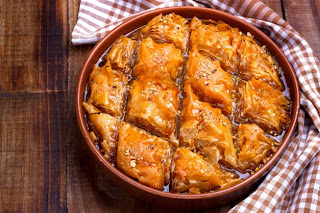LINK TO LEBANESE RECIPES COLLECTIONS
LINK TO LEBANESE-INPIRED RECIPES
LINK TO INSANELY GOOD LEBANESE RECIPES
LINK TO THE BEST LEBANESE RECIPES
--------------------------------------------------------------
SYRIAN CUISINE
ACCORDING TO WIKIPEDIA
Syrian cuisine is a Middle Eastern cuisine that includes the cooking traditions and practices of modern Syria (as opposed to Greater Syria), merging the habits of people who settled in Syria throughout its history.
Syrian cuisine mainly
uses eggplnt, zucchini, garlic, meat (mostly
from lamb
and sheep), sesame seeds, rice, chickpeas, fava
beans, lentils, cabbage, cauliflower, vine
leaves, pickled turnips, cucumbers, tomatoes, olive
oil, lemon juice, mint, pistachios, honey and
fruits.
At the beginning of the 21st century, selections of appetizers known as mezze are customarily served along with Arabic bread before the Syrian meal's main course, which is followed by coffee, with sweet confections or fruits at will. Many recipes date from at least the 13th century.
Kibbeh
Muhama

Maqluba
Baklava
SYRIAN LINKS BELOW
LINK to Allrecipes Syrian Recipes
LINK to Olive magazine Syrian Recipes
LINK to Syrian Recipes from Trip101
----------------------------
JORDANIAN CUISINE
Jordanian cuisine is a part of Levantine cuisine and shares many traits and similarities with the cuisine of Lebanoan, Palestine and Syria, often with some local variations. More generally Jordanian cuisine is influenced by historical connections to the cuisine of Turkey and the former Ottoman empire. Jordanian cuisine is also influenced by the cuisines of groups who have made a home for themselves in modern Jordan, including Armenians, Circassionans, Iraqis, Palistinians and Syrians.
Food is a very important aspect of Jordanian culture. In villages, meals are a community event with immediate and extended family present. In addition, food is commonly used by Jordanians to express their hospitality and generosity. Jordanians serve family, friends, and guests with great pride in their homes, no matter how modest their means. A "Jordanian invitation" means that one is expected to bring nothing and eat everything.
Celebrations in Jordan are marked with dishes from Jordanian cuisine spread out and served to the guests. Customs such as weddings, birth of a child, funerals, birthdays and specific religious and national ceremonies such as Ramadan and Jordan's independence day all call for splendid food to be served to guests. To celebrate the birth of a child, karawiya, a caraway-flavoured pudding, is commonly served to guests.
LINK to most popular Jordanian Foods
Wiki link to Jordanian Cuisine
 |
TURKISH CUISINE
Turkish cuisine (Turkish: Türk mutfağı) is largely the heritage of Ottoman cuisine, which can be described as a fusion and refinement of Mediterranean, Balkan, Middle Eastern, Central Asian, Eastern European, Armenian and Georgian neighbouring cuisines, including those of Southeastern Europe (Balkans) Central and Western Europe. The Ottomans fused various culinary traditions of their realm with influences from Mesopotamian cuisine, Greek cuisine, Levantine cuisine, Egyptian cuisine, Balkan cuisine, along with traditional Turkic elements from Central Asia (such as ayran and kaymak), creating a vast array of specialities.
LINK to Traditional Turkish Cuisine






















No comments:
Post a Comment